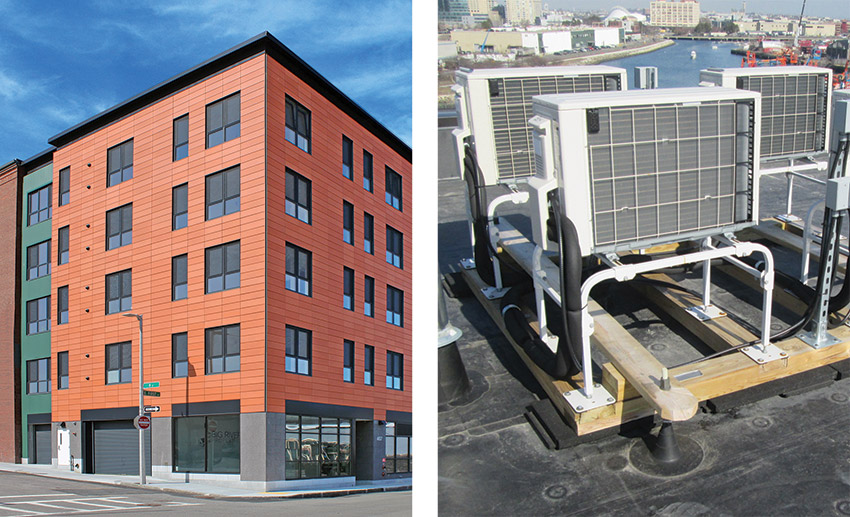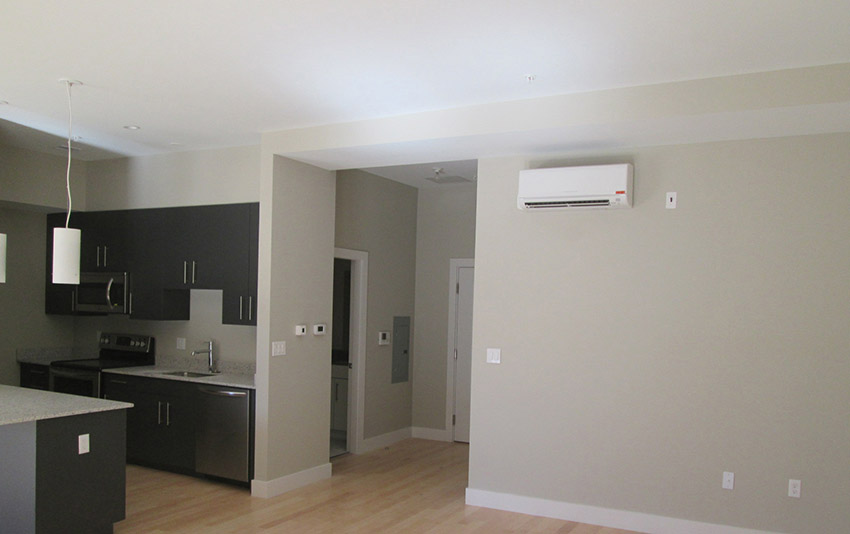This CE Center article is no longer eligible for receiving credits.
Exterior Panel Trim
With the WRB and drainage addressed, holding cladding in place is another opportunity for simplification and efficiency. Typically, some sort of trim has been applied to accomplish this using wood, composite, or plastic based materials. While those are effective and can be good for some buildings, their width, bulk, and ongoing maintenance can make them less desirable for use and detract from the overall facade design. An alternative to traditional exterior trim is the use of thin, extruded aluminum trim systems. When used to hold the edges of exterior wall panels, or siding, it provides architects with a unique means to detail corners, vertical and horizontal joints, and material transitions.
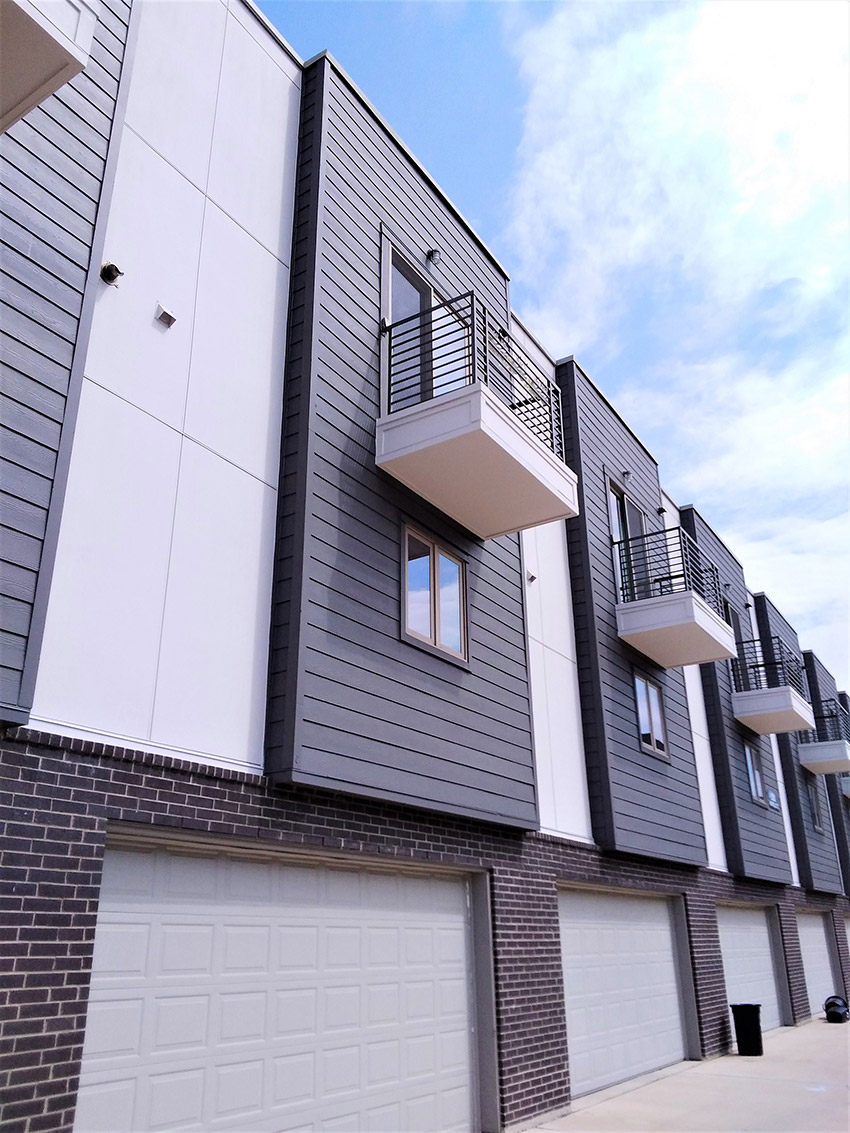
Photo courtesy of Tamlyn
Extruded aluminum trim can be used to help secure and frame exterior cladding edges using either 1-piece or 2-piece
product offerings.
In particular, two-piece extruded aluminum profiles are recommended for greater construction efficiency in handling tougher detailing situations. The two-piece design permits application of the base part first and then installation of the cover cap afterward. In tight fit situations this may be more efficient compared to using the standard trim pieces for inside or outside corners or for transitions. Due to the natural expansion and contraction of aluminum, all two-piece caps must be secured by adhesive or other means as approved by the manufacturer.
Aluminum trim, in both one-piece and two-piece solutions, can be specified in common thicknesses and profiles to suit any of the lightweight cladding materials commonly in use. Extruded aluminum trim can even be provided in sizes and styles that work with multiple panels enabling architects to vary the material choices within their facade designs while still keeping details that will have a similar language. The variety of available extrusion profiles can create a recessed reveal between cladding panels or can project outward to accentuate the lines of the design. Used in any of these ways, it has typically been shown to be less expensive with a more elegant look of clean lines than with other options.
Efficient Vrf Air-Source Heat Pump Systems
In multifamily buildings, energy use in each unit can vary widely based on occupant lifestyle and preferences. In order to achieve better control of energy use (and the costs associated with it) an energy-efficient, high-performance HVAC solution is needed. An increasingly popular solution is to use Variable Refrigerant Flow (VRF) systems for both cooling and heating of the dwelling units. The nature of these systems is to use an external heat pump connected to ductless or ducted indoor units that deliver heating or cooling.
System Options
As VRF zoned systems have become more popular, the range of choices for their installation has increased. By now, the “mini-split” system with a wall-mounted indoor unit has become familiar to many design professionals and consumers. However, there are many other options available including ceiling cassettes that can be surface-mounted or recessed and ducted styles such as compact air handlers. At least one manufacturer offers a cassette system that recesses between ceiling joists to provide a clean, flush-mount appearance. The slim body design fits into the shallow ceiling framing cavities, making it a desirable solution for renovation projects or new buildings that use wood framed construction. High/low ceiling airflow settings and automatic vane control features allow for personalized room comfort when using these systems.
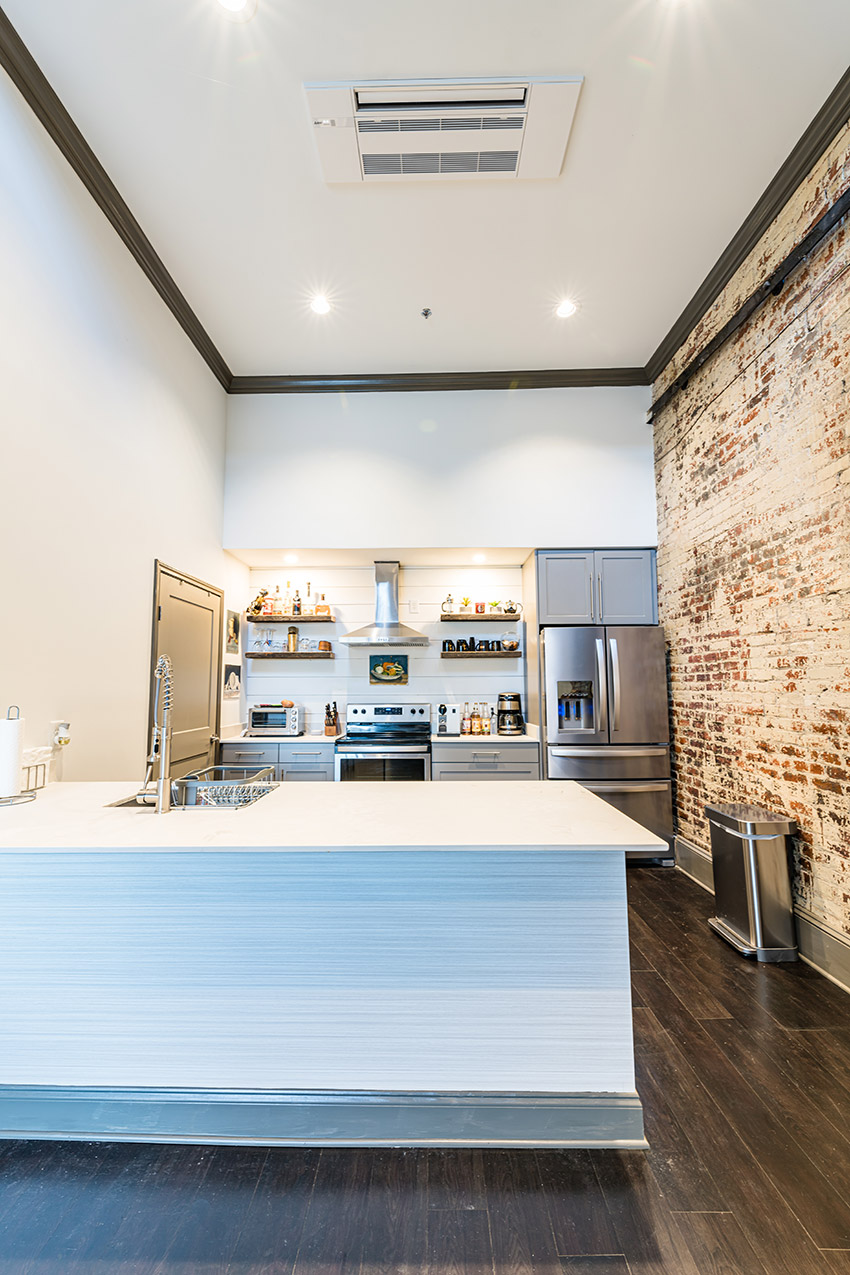
Photo courtesy of Mitsubishi Electric Trane HVAC US
This multifamily renovation project in Macon, Georgia uses recessed ceiling cassettes, which fit between standard 16-inch joists to provide efficient, attractive, and economical heating and cooling.
The capacity range of VRF systems is also appealing, particularly for buildings that are already designed to meet high standards of energy performance. Passive House multifamily buildings, for example, are designed and constructed to dramatically reduce energy demand for heating and cooling to begin with. As such, the heating and cooling output requirements of an HVAC unit for an individual living space can be much lower. Finding and matching appropriately sized equipment to the energy needs of those dwellings is much easier with VRF zoning systems than with other types of heating and cooling equipment.
Zoning and Controls
The efficiency of VRF systems comes not only from their all-electric, high-performance technology, but also from the ability to create zoning and control solutions that suit occupants’ unique needs in each room or space. That means only the precise amount of energy needed to heat or cool a space is used, which can significantly improve a building’s overall efficiency. With zoning capabilities, occupants in multifamily buildings can enjoy individual comfort control with no impact from neighboring apartments or condos.
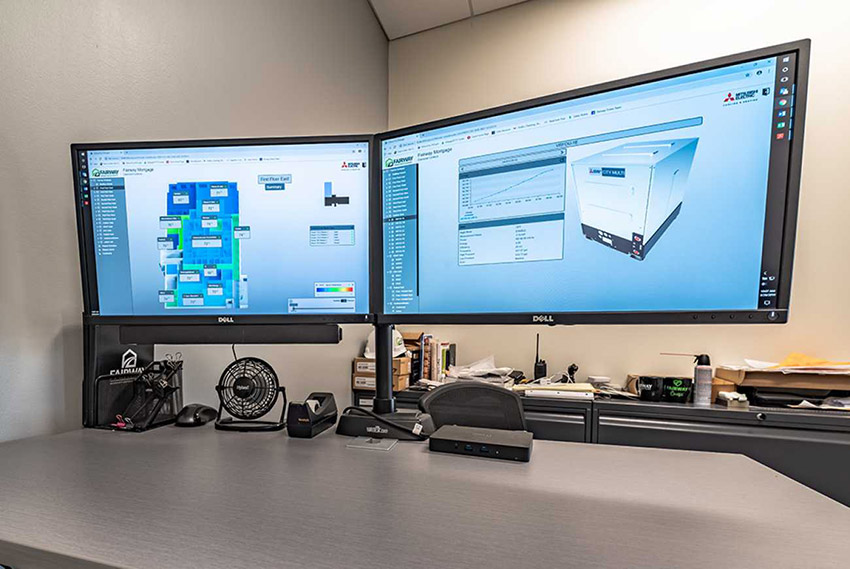
Photo courtesy of Mitsubishi Electric Trane HVAC US
The control of VRF systems can be centralized for large buildings and tied directly into a whole-building energy management system.
For common spaces, community areas, or amenity locations, VRF heat pumps combined with air handlers and heat recovery equipment can meet spaces’ specific needs with comparable efficiency. In these cases, comprehensive controls solutions for VRF systems allow building owners to manage energy usage and streamline maintenance needs on a large scale. Seamless interfaces are possible for whole-building controls solutions which can integrate the control of VRF technology with energy recovery ventilation equipment and other third-party systems. If certain amenities and community areas are closed overnight, for example, airflow can be turned off or the temperature set back during off hours and automatically restarted in the morning. Similarly, airflow and temperature can be adjusted to meet occupancy needs in high-trafficked public areas, such as lobbies or gyms, during peak times. On the tenant level, certain VRF system controls can be configured for accessibility via smart phone-based apps. These individual control solutions can be compatible with modern smart home technologies to ensure residents have individual comfort control right at their fingertips.
Design Coordination
Part of the design appeal of VRF systems is their design flexibility and varied styles, which can meet a range of aesthetic and spatial conditions. Outdoor units, regardless of tonnage, often boast a smaller footprint than conventional outdoor compressors, allowing for more usable rooftop or building-side space for amenities. Ultra-quiet sound levels allow tenants to enjoy nearby amenities without the distraction of sound. Inside the building, conditioned refrigerant is transferred to indoor units via small-diameter piping minimizing the space needed for piping runs. For ducted situations, only short or compact duct runs are typically needed. All of this means that usable building space is maximized by reducing the need for bulkheads or additional plenums. Perhaps most notably, the units are distributed rather than centralized, which means space requirements for mechanical rooms are also reduced. Architects can utilize all these design considerations to demonstrate how the use of VRF systems can actually lead to overall construction cost savings. For instance, buildings that no longer require plenums for ductwork can be designed to be shorter, requiring less materials and labor, but still have the same amount of livable space.
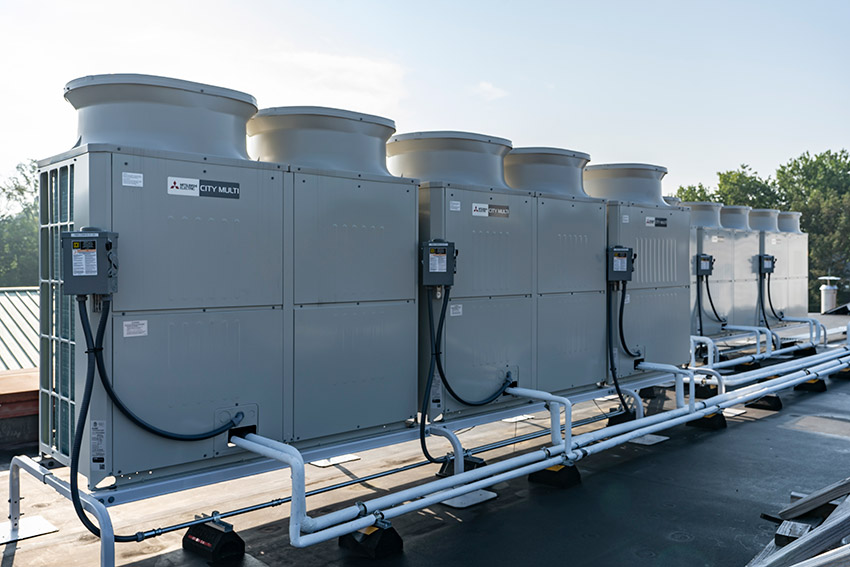
Photo courtesy of Mitsubishi Electric Trane HVAC US
The outdoor components of a VRF system are commonly much quieter and more compact than conventional heating and cooling systems.
Dennis Cobb is the senior director of business development at Mitsubishi Electric Trane HVAC US. He has seen firsthand the impact that these types of HVAC systems make on efficiency in multifamily buildings. He notes: “All-electric VRF systems are an ideal solution for multifamily projects. Tenants can enjoy custom comfort control that’s unavailable to them in apartment buildings with traditional systems, as well as cost savings thanks to system’s efficiency.
Building owners benefit from reduced costs of operation and design-friendly options that can increase their usable square footage. Quiet operation from both the indoor and outdoor units adds to the comfort of tenants and surrounding communities. They’re really great systems for everyone involved.” He also notes that when design professionals partner directly with VRF companies during design, they can provide manufacturer support to help streamline equipment design selections, system startup, maintenance, and ongoing management for optimized performance.
Multifamily housing is often comprised of complex combinations of living units and public spaces that can sometimes seem to defy the nature of true efficiency. Multiple households with varying lifestyles plus common amenity areas with varied occupancy throughout the day all need to be contained within the architectural design and construction of the facility. Add in the desire to provide buildings that are healthy and appealing to live in while also achieving high levels of energy saving performance and it’s easy to see that design professionals face a complicated task. This course looks at several ways to break through and perhaps simplify the design and decision-making process for excellence in multifamily housing. A particular focus is on the ways to create multifamily projects that excel in energy performance using the Passive House standard as a reference (https://multifamily.phius.org/). In recent years, this standard has seen a dramatic growth in use particularly for multifamily housing since it provides a climate specific, density related means to assess and achieve cost-effective energy reductions.
Better Building Facades
Part of the reason for the success of Passive House in the United States, as used in multifamily construction, is the emphasis on fundamental principles associated with both physics and good building practices. That is strongly evidenced in building facades or enclosures where the importance of thermal control is coupled with the significance of air and moisture control. In that light, the use of quality water resistant barriers (WRBs) and rainscreen assemblies is addressed which allows for both resistance to water and the ability for air-induced drying should any moisture be present in the construction assembly. There are, of course, multiple ways to configure exterior walls to achieve water resistance and air drying.
Drainable Building Wrap
One approach that has been in use for more than 10 years is the use of drainable building wraps that enhance the capabilities of WRBs. Specifically, a drainable wrap provides non-compressible elements thermally bonded to a high-quality WRB that provides the necessary water hold-out and air hold-out to create a drainable gap between the WRB and cladding. This type of product pairs very well with fiber cement, which is still a widely used material in the multifamily sector from affordable to market rate.
When properly used and installed, this innovative product effectively removes excess moisture and mitigates the damaging effects it can cause, including mold and rot. The effectiveness of drainable building wrap has been shown to remove on the order of 100 times more bulk water from a wall and can drain it away twice as fast as standard housewraps. This is achieved through the gap created by 1.5-millimeter spacers bonded to a high-performance housewrap. This gap design provides a true drainage space or capillary break between the sheathing and cladding material. It is also available as a vapor permeable product, meaning that it can repel bulk water but allow any moisture that is behind it to migrate out and drain away harmlessly. Overall, this single product provides the drying capability of a 3⁄8-inch rainscreen.
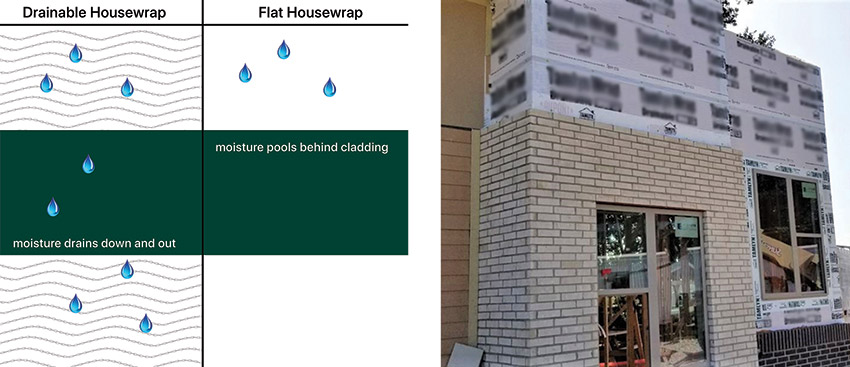
Photos courtesy of Tamlyn
Drainable building wrap provides a barrier between the WRB and the cladding to assist with moisture control and drying. It provides these attributes whether installed behind a single cladding or even multiple cladding materials on the same project.
While this approach offers considerable efficiencies in moisture control and drying, it also helps to streamline construction. The pre-installed raised texture allows the wrap and the drainage to be installed in one step. The most cost-effective products can even be installed in any position: horizontally, vertically, or diagonally.
Beyond the product itself, sealing the edges and seams properly and fully without undue penetrations from staples or nails is critical for good performance and code compliance. Some manufacturers offer full sealing systems that use a compatible adhesive, sealant, or tape. This allows the edges to be held permanently in place, usually by using a hard roller or hand applicator to press the wrap and the tape together. Such products may also use fasteners with plastic heads that minimize the impact of the fastener penetrations and help maintain the barrier continuity.
Equally important are the details of how the drainable building wrap deals with openings in the wall such as doors and windows. Being able to flash and seal the wrap properly with window and door flashing materials will assure that water draining down the face of a drainable WRB will flow away properly and not enter behind other building elements into the wall. It will also maintain the continuity of the air barrier in the overall system.
Since these types of products are commonly used, their installation is well known among the trades, however it is always recommended to follow manufacturer’s instructions and best practice guidelines. (see Best Practice Installation Case Study).
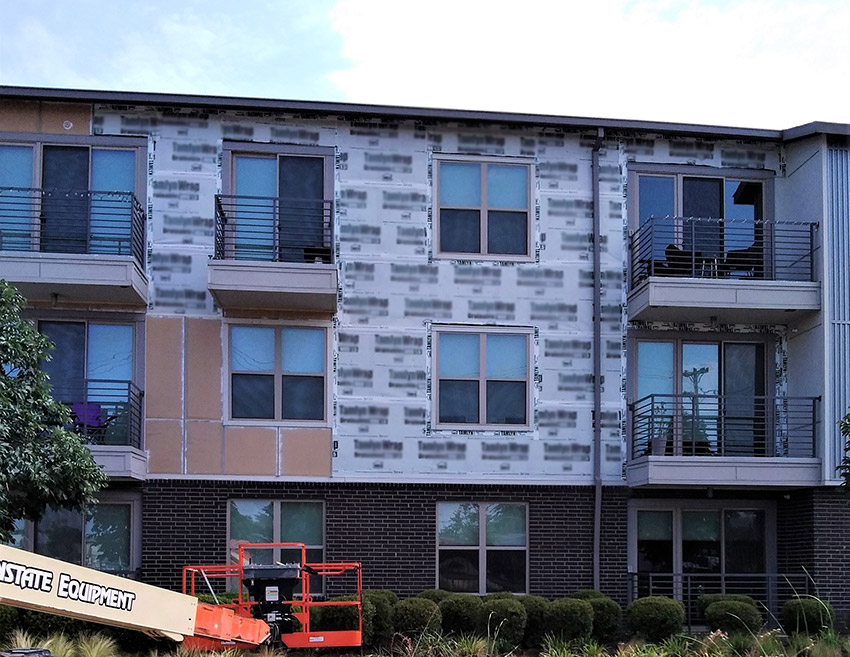
Photo courtesy of Tamlyn
Installation of drainable building wrap should always follow manufacturer’s instructions and general best practices.
Non-Compressible Mat Rainscreen
An enhanced version of drainable building wrap is also available for projects seeking even greater efficiency and performance. This product has non-compressible round posts that are on the order of 6.3 millimeter (1⁄4 inch) or 10.1 millimeter (3⁄8 inch) between two layers to enhance drainage efficiency, drying proficiency, and improve construction expediency. This makeup provides a more substantial air cavity between the cladding and the sheathing material by creating a larger drainage and drying space than drainable wrap products. These non-compressible mat rainscreens help the wall sheathing (i.e., OSB with WRB, coated OSB, etc.) to dry faster and last much longer than usual. The back of any cladding (i.e., stucco, fiber cement board, stone, metal panels, etc.) can also be dried more efficient since the 6.3-millimeter-thick filament is uncompressible and can act essentially as furring strips. This helps reduce the installation time and cost as well as the associated liability of other systems.
Exterior Panel Trim
With the WRB and drainage addressed, holding cladding in place is another opportunity for simplification and efficiency. Typically, some sort of trim has been applied to accomplish this using wood, composite, or plastic based materials. While those are effective and can be good for some buildings, their width, bulk, and ongoing maintenance can make them less desirable for use and detract from the overall facade design. An alternative to traditional exterior trim is the use of thin, extruded aluminum trim systems. When used to hold the edges of exterior wall panels, or siding, it provides architects with a unique means to detail corners, vertical and horizontal joints, and material transitions.

Photo courtesy of Tamlyn
Extruded aluminum trim can be used to help secure and frame exterior cladding edges using either 1-piece or 2-piece
product offerings.
In particular, two-piece extruded aluminum profiles are recommended for greater construction efficiency in handling tougher detailing situations. The two-piece design permits application of the base part first and then installation of the cover cap afterward. In tight fit situations this may be more efficient compared to using the standard trim pieces for inside or outside corners or for transitions. Due to the natural expansion and contraction of aluminum, all two-piece caps must be secured by adhesive or other means as approved by the manufacturer.
Aluminum trim, in both one-piece and two-piece solutions, can be specified in common thicknesses and profiles to suit any of the lightweight cladding materials commonly in use. Extruded aluminum trim can even be provided in sizes and styles that work with multiple panels enabling architects to vary the material choices within their facade designs while still keeping details that will have a similar language. The variety of available extrusion profiles can create a recessed reveal between cladding panels or can project outward to accentuate the lines of the design. Used in any of these ways, it has typically been shown to be less expensive with a more elegant look of clean lines than with other options.
Efficient Vrf Air-Source Heat Pump Systems
In multifamily buildings, energy use in each unit can vary widely based on occupant lifestyle and preferences. In order to achieve better control of energy use (and the costs associated with it) an energy-efficient, high-performance HVAC solution is needed. An increasingly popular solution is to use Variable Refrigerant Flow (VRF) systems for both cooling and heating of the dwelling units. The nature of these systems is to use an external heat pump connected to ductless or ducted indoor units that deliver heating or cooling.
System Options
As VRF zoned systems have become more popular, the range of choices for their installation has increased. By now, the “mini-split” system with a wall-mounted indoor unit has become familiar to many design professionals and consumers. However, there are many other options available including ceiling cassettes that can be surface-mounted or recessed and ducted styles such as compact air handlers. At least one manufacturer offers a cassette system that recesses between ceiling joists to provide a clean, flush-mount appearance. The slim body design fits into the shallow ceiling framing cavities, making it a desirable solution for renovation projects or new buildings that use wood framed construction. High/low ceiling airflow settings and automatic vane control features allow for personalized room comfort when using these systems.

Photo courtesy of Mitsubishi Electric Trane HVAC US
This multifamily renovation project in Macon, Georgia uses recessed ceiling cassettes, which fit between standard 16-inch joists to provide efficient, attractive, and economical heating and cooling.
The capacity range of VRF systems is also appealing, particularly for buildings that are already designed to meet high standards of energy performance. Passive House multifamily buildings, for example, are designed and constructed to dramatically reduce energy demand for heating and cooling to begin with. As such, the heating and cooling output requirements of an HVAC unit for an individual living space can be much lower. Finding and matching appropriately sized equipment to the energy needs of those dwellings is much easier with VRF zoning systems than with other types of heating and cooling equipment.
Zoning and Controls
The efficiency of VRF systems comes not only from their all-electric, high-performance technology, but also from the ability to create zoning and control solutions that suit occupants’ unique needs in each room or space. That means only the precise amount of energy needed to heat or cool a space is used, which can significantly improve a building’s overall efficiency. With zoning capabilities, occupants in multifamily buildings can enjoy individual comfort control with no impact from neighboring apartments or condos.

Photo courtesy of Mitsubishi Electric Trane HVAC US
The control of VRF systems can be centralized for large buildings and tied directly into a whole-building energy management system.
For common spaces, community areas, or amenity locations, VRF heat pumps combined with air handlers and heat recovery equipment can meet spaces’ specific needs with comparable efficiency. In these cases, comprehensive controls solutions for VRF systems allow building owners to manage energy usage and streamline maintenance needs on a large scale. Seamless interfaces are possible for whole-building controls solutions which can integrate the control of VRF technology with energy recovery ventilation equipment and other third-party systems. If certain amenities and community areas are closed overnight, for example, airflow can be turned off or the temperature set back during off hours and automatically restarted in the morning. Similarly, airflow and temperature can be adjusted to meet occupancy needs in high-trafficked public areas, such as lobbies or gyms, during peak times. On the tenant level, certain VRF system controls can be configured for accessibility via smart phone-based apps. These individual control solutions can be compatible with modern smart home technologies to ensure residents have individual comfort control right at their fingertips.
Design Coordination
Part of the design appeal of VRF systems is their design flexibility and varied styles, which can meet a range of aesthetic and spatial conditions. Outdoor units, regardless of tonnage, often boast a smaller footprint than conventional outdoor compressors, allowing for more usable rooftop or building-side space for amenities. Ultra-quiet sound levels allow tenants to enjoy nearby amenities without the distraction of sound. Inside the building, conditioned refrigerant is transferred to indoor units via small-diameter piping minimizing the space needed for piping runs. For ducted situations, only short or compact duct runs are typically needed. All of this means that usable building space is maximized by reducing the need for bulkheads or additional plenums. Perhaps most notably, the units are distributed rather than centralized, which means space requirements for mechanical rooms are also reduced. Architects can utilize all these design considerations to demonstrate how the use of VRF systems can actually lead to overall construction cost savings. For instance, buildings that no longer require plenums for ductwork can be designed to be shorter, requiring less materials and labor, but still have the same amount of livable space.

Photo courtesy of Mitsubishi Electric Trane HVAC US
The outdoor components of a VRF system are commonly much quieter and more compact than conventional heating and cooling systems.
Dennis Cobb is the senior director of business development at Mitsubishi Electric Trane HVAC US. He has seen firsthand the impact that these types of HVAC systems make on efficiency in multifamily buildings. He notes: “All-electric VRF systems are an ideal solution for multifamily projects. Tenants can enjoy custom comfort control that’s unavailable to them in apartment buildings with traditional systems, as well as cost savings thanks to system’s efficiency.
Building owners benefit from reduced costs of operation and design-friendly options that can increase their usable square footage. Quiet operation from both the indoor and outdoor units adds to the comfort of tenants and surrounding communities. They’re really great systems for everyone involved.” He also notes that when design professionals partner directly with VRF companies during design, they can provide manufacturer support to help streamline equipment design selections, system startup, maintenance, and ongoing management for optimized performance.
Efficient Fenestration
Creating multifamily living units with abundant light and ventilation is both an occupant desire and a code requirement. Design professionals often like to maximize the opportunity for light, views, and ventilation as part of the overall design of a project and to add some distinction to a project helping developers more readily rent or sell the units. Additionally, Passive House and other green building standards recognize the healthy benefits to occupants who have access to daylight, ventilation, and views. The performance issue, of course, is to find the right balance between the use of fenestration to let light and ventilation in compared to the need to control the flow of heat into or out of the space. Since an insulated opaque wall will always be more effective at controlling air infiltration and thermal transfer, it becomes incumbent on the architect to select fenestration that provides the desired design features while still meeting standards for high performance and efficiency.
Balancing Design with Performance
Multifamily designs often seek to provide occupants with expansive views and a visual connection to the surrounding landscape or cityscape. Manufacturers of larger format fenestration recognize this design need and offer products that are easily incorporated into a variety of building design schemes. At the same time, they also recognize the need to provide high performance to meet energy use requirements. That means the glass selected in multi-pane units provides the needed levels of restricting thermal heat flow or solar heat gain as related to the building’s climate zone. It also means the frames are designed and constructed to similarly control heat flow and thermal bridging within them. The whole assembly then needs to open easily to provide ventilation but be able to close tightly and securely in a manner that restricts unwanted air infiltration.
Recent innovations in engineering have taken all these design and performance criteria into account to produce some appealing and efficient choices. Specifically, large format glass door systems are available with ultra-slim frames that offer virtually uninterrupted views while effectively mitigating heat transfer using thermal breaks and insulating glass. This means they are effective at working with the rest of the building envelope to help keep interior temperatures cool during hot weather and warm during cold weather. Maintaining comfortable interior temperatures places less strain on heating and cooling systems throughout the year, thus enhancing the energy efficiency of multifamily developments.
From a design standpoint, multifamily units often have fenestration limited to one or two sides of the units. In some cases, the building is designed so windows or views are similarly focused on one or two sides of a building. That means the total amount of fenestration in a building can be controlled for overall energy performance, but a living unit can appear to have large scale, dramatic openings. With this in mind, manufacturers offer grand scale, glazed, operable doors with heights over 10 feet. They also offer a minimal profile using ultra-slim panel frames. Coupled with high performance U-factors, they provide the thermal efficiency needed in new multi-family developments while delivering the expansive views that residents desire.
Mark Suhiro is technical director of the CRL Entrances & Partitions Group and has been deeply involved in this issue. He points out “When it comes to fenestration systems in modern multifamily building design, architects must find a balance between aesthetics and thermal performance.” He notes that the fenestration industry is able to find this balance with two types of systems: sliding doors and bi-folding doors.
Large-Scale Sliding Glass Doors
Large-scale sliding doors typically feature a sophisticated design that makes a visual statement. Ultra-slim panel rails and stiles, on the order of only 1-5⁄16-inch wide, create a minimal and uniform frame that produces uninterrupted views while letting daylight flow freely into interiors. Large-scale sliding glass doors are typically custom manufactured to suit a particular project, with panel heights up to 13 feet and widths up to 7 feet. That means they can provide an elegant solution that fits seamlessly with contemporary project designs.

Photo courtesy of CRL
Large-format sliding glass doors provide multifamily units with the ability to capture daylight and views while addressing the performance and efficiency concerns of the building.
Among the available features of these large format sliding doors are thermally broken frames with 1-inch insulating glass that can achieve a U-factor of 0.38. This configuration also has the capability to provide sound attenuation with ratings on the order of STC-33. The frames can be finished in a range of standard colors. Custom colors are also available from some manufacturers.
Despite the large sliding panels, this type of door is engineered to provide fairly effortless, one-handed operation. Panel loads, up to 700 pounds, are evenly distributed across a bottom rolling system with stainless steel wheels resulting in a fluid, frictionless glide. Precision-engineered stainless-steel tracks further facilitate panel movement. Operation is usually manual using a built-in door handle or groove. Due to the larger size of the doors, the locking mechanism is typically a multi-point system. The door sills can be flush to provide a seamless floor transition between the inside and outside of the doors or raised for greater protection against weather conditions.
Altogether, expansive sliding doors provide an attractive and efficient solution for large-format fenestration in multifamily buildings.
Large-Scale Bi-Folding Glass Doors
In addition to large-scale sliding doors, the latest bi-folding glass door systems also offer advancements in aesthetics and thermal performance. These systems are characterized by multiple hinged panels that can stack to one side to allow for a complete opening between rooms or between interior and exterior environments. This is particularly appealing for designs that seek to create seamless transitions between interior and exterior spaces while maximizing ventilation and daylighting. When closed, bi-folding door systems offer minimal obstruction to preserve views and can seal up tightly to effectively protect against air and water infiltration. They can feature thermally broken frames and 1-inch double-pane insulating glass that together produce standard U-factors of 0.36 to help keep interior temperatures at a comfortable level year-round, which puts less strain on air conditioning systems.

Photo courtesy of CRL
Large-format bi-folding glass doors allow for full views and ventilation when open, and weather sealing and thermal performance when closed.
On the aesthetic side, the latest bi-folding doors feature 12-foot frame heights, slim 4-3/4-inch vertical sightlines, and ultra-narrow 1-7⁄16-inch panel rails. Together, this lessens obstructions to help preserve views. When closed, door hinges are completely concealed to deliver a minimal, streamlined look.
Similar to sliding doors, bi-folding door systems are engineered to provide easy operation. Panel loads can be mounted on a bottom rolling system to eliminate strain on overhead beams. The panel widths are typically four feet with a maximum height of 12 feet. The sills for bi-folding door systems can also be flush to provide a seamless floor transition between the interior and exterior, or raised to provide better resistance to water and air infiltration.
Performance Standards
There are some recognized fenestration standards which are always evolving due to changes in manufacturing technology, building codes and rating system performance requirements. The most widely recognized and relevant standard is the North American Fenestration Standard (NAFS) which governs windows, doors, and skylights. Prepared as a joint collaboration between different organizations, the standard is known as AAMA/WDMA/CSA 101/I.S.2/A440. While this standard is familiar to many specifiers and fenestration manufacturers, the latest version referenced in the current International Building Codes has realigned and changed a bit. Most significantly, a not-so-recent change reduced the total number of Performance Class designations as defined by the Performance Grade (a set of performance requirements corresponding to a Design Pressure range) at the intended location of the building. It is important that specifiers recognize this change and not rely on older versions of this standard which included five performance classes, described as: “R” for Residential, “LC” for Light Commercial, “C” for Commercial, “HC” for Heavy Commercial and “AW” for Architectural. In the most current edition of NAFS, the “C” and “HC” performance classifications have been eliminated and a new “CW” classification has been added for Commercial fenestration. This reduces the total number of performance classifications from five to four and puts the emphasis for testing and performance on meeting the criteria for these Performance Grades.
To be classified into one of these four Performance Grade categories, independent testing is required based on the design pressure of wind forces acting on the fenestration (measured in pounds per square foot—psf) at a stated pressure difference (measured in pascals Pa). The entry-level or “gateway” criteria for tested fenestration units in each of the Performance Grades is as follows:
- R Class Fenestration: 15 psf (720 Pa) This class is commonly used in one- and two-family dwellings.
- LC Class Fenestration: 25 psf (1200 Pa) This class is the minimum designation appropriate for low- and mid-rise multifamily dwellings and other buildings where larger sizes and higher loading requirements are expected.
- CW Class Fenestration: 30 psf (1,440 Pa) This newest class is better suited to low- and mid-rise buildings where larger sizes, higher loading requirements, limits on deflection, and heavier use are expected.
- AW Class Fenestration: 40 psf (1,920 Pa) This is geared toward mid- and high-rise buildings to meet increased loading requirements and limits on deflection in buildings where frequent and extreme use of the fenestration products is expected.
These descriptions and testing levels are intended to act as a general guide in helping to determine which class is best suited for a particular application. In the case of multifamily buildings, it is clear that LC is the minimum classification needed. However, it is preferable, in most cases, to specify CW class fenestration for low- and mid-rise multifamily buildings to allow optimal performance in a greater range of design conditions.
In the case of large-format glass doors, both sliding and bi-folding versions, CW class units are now available from select manufacturers. That means that they have been independently tested and shown to meet the criteria to qualify for this preferred class of fenestration. This helps design professionals when selecting and specifying such products, but ultimately it means it benefits the owners and occupants of multifamily buildings. The ratings reflect performance features that help achieve the goal of reducing energy use while still meeting design intents. This adds to a building’s overall sustainability and visual appeal.
Conclusion
Creating efficient multifamily housing is a multifaceted task. The Passive House standard is one means to improve the energy efficiency while addressing cost-effective construction techniques. The building envelope can be enhanced with the proper use of WRBs, enhanced with drainable capability, and the cladding finished with aluminum trim. Cooling and heating can be provided with appropriately sized, high efficiency, VRF systems and air-source heat pumps. Fenestration can be addressed by selecting large-scale sliding or folding glass doors that provide light and ventilation along with high performance. These and other similar strategies lead to an overall design that meets the needs of the building owner, the occupants, and the environment.
Peter J. Arsenault, FAIA, NCARB, LEED-AP is a nationally known architect, continuing education presenter, and a prolific author advancing more efficient building design through better design. www.pjaarch.com, www.linkedin.com/in/pjaarch










